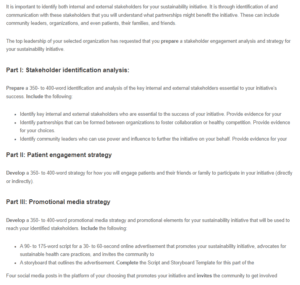Sustainability Initiative Stakeholder Engagement Analysis and Strategy
Part I: Stakeholder Identification Analysis
In the context of the proposed sustainability initiative for Device Reprocessing in healthcare, it is crucial to identify and analyze critical internal and external stakeholders who are essential to the success of the initiative.
Internal Stakeholders
Internally, the principal entities of interest include healthcare personnel, administrative personnel, and individuals seeking medical care. Healthcare personnel, encompassing nurses, physicians, and technicians, are actively engaged in the execution of the device reprocessing initiative, as elucidated by Hennein et al. (2022) and Panta et al. (2022). The acquisition of their endorsement and vigorous engagement in the training and implementation of reprocessing protocols are imperative for the triumph of the program. Administrators possess the prerogative to apportion resources and render determinations about the allocation of funds, acquisition of equipment, and modifications to the facility in question. Their support is paramount in guaranteeing the appropriate allocation of essential resources. Patients, the ultimate beneficiaries of medical devices, are vested in the caliber and security of reprocessed devices. The reliance on reprocessed devices’ integrity and efficacy is of utmost importance. Do you need help in completing your assignment?
External Stakeholders
Externally, crucial stakeholders include regulatory bodies such as the FDA, environmental agencies, and sustainability-focused organizations. Compliance with FDA and other regulatory guidelines is mandatory to ensure the safety and quality of reprocessed medical devices. On the other hand, environmental agencies monitor and regulate waste disposal practices, which directly relate to the environmental impact reduction aspect of the initiative. Furthermore, collaboration with sustainability-focused organizations can provide valuable insights and connections to other healthcare institutions that have successfully implemented similar sustainability initiatives.
Partnerships
Partnerships can be formed between healthcare organizations, waste management companies, and sustainability-focused non-profit organizations (European Commission, n.d.). Collaborating with waste management companies can ensure proper disposal and recycling of medical waste generated during reprocessing, aligning with environmental goals (Boccato et al., 2022). Sustainability-focused non-profits can provide guidance and support, helping the healthcare organization make well-informed decisions related to sustainability initiatives.
Community Leaders
Community leaders who can leverage their influence include local politicians, environmental activists, and patient advocacy groups. Local politicians can advocate for the initiative at the municipal level and help secure grants or incentives. Environmental activists can raise awareness about the positive environmental impact of device reprocessing, garnering support from the community (Boccato et al., 2022). Patient advocacy groups can vouch for the safety and quality of reprocessed devices, assuaging patient concerns and building trust in the initiative.
Part II: Patient Engagement Strategy
The patient engagement strategy for the Device Reprocessing initiative is designed to ensure that patients and their families are well-informed, comfortable, and actively involved in the initiative. This strategy employs a multi-faceted approach to achieve these goals.
Firstly, we will prioritize education and communication. To achieve this, we will create informative brochures and pamphlets that clearly explain reprocessed medical devices’ safety and quality control processes. These materials will be strategically distributed in waiting areas and patient rooms, ensuring that patients and their families have easy access to information addressing any concerns.
In addition, we will develop an online resource center on the hospital’s website dedicated to the Device Reprocessing initiative. This section will offer comprehensive information, including frequently asked questions (FAQs), success stories, and video testimonials from patients who have experienced the benefits of reprocessed devices. This online platform aims to provide a convenient and detailed source of information for patients and their families to explore at their own pace.
Furthermore, open forums and town hall meetings will be organized periodically. These events will serve as platforms where patients and their families can directly engage with healthcare professionals, ask questions, and express concerns regarding reprocessed devices. Transparent and honest communication in these forums will be essential in building trust and addressing apprehensions.
Subsequently, we will establish a feedback mechanism to continuously improve the initiative and ensure a high standard of patient care. This may be a dedicated hotline or an online portal where patients can report their experiences with reprocessed devices. Patient feedback will be valued and used to make ongoing refinements, guaranteeing that the initiative aligns with patient needs and expectations.
Part III: Promotional Media Strategy
The promotional media strategy for the Device Reprocessing initiative aims to raise awareness, advocate for sustainable healthcare practices, and invite the community to action.
Storyboard
| # | SCRIPT | STORYBOARD |
| 1 | “Every day, healthcare generates tons of waste, but what if we told you there’s a better way? Introducing Device Reprocessing – a sustainable solution. We reprocess medical devices, saving costs and the environment. Join us on this green journey for a healthier future. Learn more at our website.” |  
Visuals of medical professionals using reprocessed devices, a clean and eco-friendly hospital environment, and happy patients. |
| 2 | “Imagine a world where healthcare not only heals but also heals our planet. With Device Reprocessing, we’re making that a reality. Join us in reducing waste, saving costs, and ensuring a healthier future. Discover more at our website.” |  |
| 3 | “At our Hospital, we’ve taken a pledge to care for everyone’s health and our environment. Device Reprocessing is the way forward. We are reusing devices, reducing waste, and embracing sustainability. Will you join us? Learn more at our website.” |  |
Social Media Posts
The following messages will be shared across social media platforms like LinkedIn, Facebook, Twitter and Instagram.
- “Did you know we reduce waste and save costs with Device Reprocessing? Join us in the quest for sustainable healthcare. #SustainableHealthcare #DeviceReprocessing”
- “Your safety and the environment matter to us. Device Reprocessing is our way of ensuring quality care while minimizing waste. Be a part of the change. #EcoFriendlyHealthcare #Sustainability”
- “Have questions about Device Reprocessing? We are here to answer them. Join our online town hall on [date] to learn more and get involved. #AskUsAnything #SustainableInitiative.”
- “Be a part of the movement towards sustainable healthcare. Support Device Reprocessing and help us make a difference in the community. #SustainabilityMatters #GetInvolved.”
In summation, the Device Reprocessing initiative in healthcare involves identifying key stakeholders, engaging patients, and implementing a promotional media strategy to raise awareness and advocate for sustainable practices. This comprehensive approach is designed to make the initiative a success.
References
Boccato, C., Cerutti, S., & Vienken, J. (2022). Medical devices: Improving Health care through a multidisciplinary approach. Springer Nature.
European Commission. (n.d.). Reprocessing of medical devices. Health.ec.europa.eu. https://health.ec.europa.eu/medical-devices-topics-interest/reprocessing-medical-devices_en
Hennein, R., Goddard, E., & Sherman, J. D. (2022). Stakeholder perspectives on scaling up medical device reprocessing: A qualitative study. PLOS ONE, 17(12), e0279808. https://doi.org/10.1371/journal.pone.0279808
Panta, G., Richardson, A. K., Shaw, I. C., & Coope, P. A. (2022). Healthcare workers’ knowledge and attitudes towards sterilization and reuse of medical devices in primary and secondary care public hospitals in Nepal: A multi-centre cross-sectional survey. PLOS ONE, 17(8), e0272248. https://doi.org/10.1371/journal.pone.0272248
ORDER A PLAGIARISM-FREE PAPER HERE
We’ll write everything from scratch
Question

Sustainability Initiative Stakeholder Engagement Analysis and Strateg
It is important to identify both internal and external stakeholders for your sustainability initiative. It is through identification of and communication with these stakeholders that you will understand what partnerships might benefit the initiative. These can include community leaders, organizations, and even patients, their families, and friends.
The top leadership of your selected organization has requested that you prepare a stakeholder engagement analysis and strategy for your sustainability initiative.
Part I: Stakeholder identification analysis:
Prepare a 350- to 400-word identification and analysis of the key internal and external stakeholders essential to your initiative’s success. Include the following:
- Identify key internal and external stakeholders who are essential to the success of your initiative. Provide evidence for your
- Identify partnerships that can be formed between organizations to foster collaboration or healthy competition. Provide evidence for your choices.
- Identify community leaders who can use power and influence to further the initiative on your behalf. Provide evidence for your
Part II: Patient engagement strategy
Develop a 350- to 400-word strategy for how you will engage patients and their friends or family to participate in your initiative (directly or indirectly).
Part III: Promotional media strategy
Develop a 350- to 400-word promotional media strategy and promotional elements for your sustainability initiative that will be used to reach your identified stakeholders. Include the following:
- A 90- to 175-word script for a 30- to 60-second online advertisement that promotes your sustainability initiative, advocates for sustainable health care practices, and invites the community to
- A storyboard that outlines the advertisement. Complete the Script and Storyboard Template for this part of the
Four social media posts in the platform of your choosing that promotes your initiative and invites the community to get involved

